

Cernunnos. Cernunnos is the conventional name given in Celtic studies to depictions of the "horned god" of Celtic polytheism.
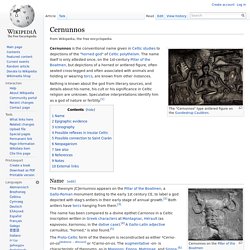
The name itself is only attested once, on the 1st-century Pillar of the Boatmen, but depictions of a horned or antlered figure, often seated cross-legged and often associated with animals and holding or wearing torcs, are known from other instances. Nothing is known about the god from literary sources, and details about his name, his cult or his significance in Celtic religion are unknown. Speculative interpretations identify him as a god of nature or fertility.[1] Name[edit] The theonym [C]ernunnos appears on the Pillar of the Boatmen, a Gallo-Roman monument dating to the early 1st century CE, to label a god depicted with stag's antlers in their early stage of annual growth.[2] Both antlers have torcs hanging from them.[3] The Proto-Celtic form of the theonym is reconstructed as either *Cerno-on-os[dubious ] or *Carno-on-os.
Epona. Epona, third century AD, from Freyming (Moselle), France (Musée Lorrain, Nancy)
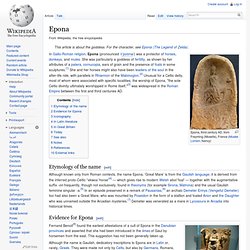
Ceridwen. In Welsh medieval legend, Ceridwen was an enchantress.
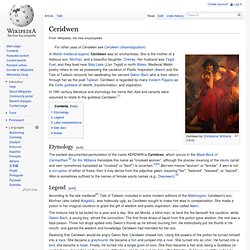
She is the mother of a hideous son, Morfran, and a beautiful daughter, Creirwy. Her husband was Tegid Foel, and they lived near Bala Lake (Llyn Tegid) in north Wales. Medieval Welsh poetry refers to her as possessing the cauldron of Poetic Inspiration (Awen) and the Tale of Taliesin recounts her swallowing her servant Gwion Bach who is then reborn through her as the poet Taliesin. Ceridwen is regarded by many modern Pagans as the Celtic goddess of rebirth, transformation, and inspiration. In 19th century literature and etymology the name Ket, Ked and variants were assumed to relate to the goddess Ceridwen.[1] Etymology[edit] Legend[edit] According to the late medieval[6] Tale of Taliesin, included in some modern editions of the Mabinogion, Ceridwen's son, Morfran (also called Afagddu), was hideously ugly, so Ceridwen sought to make him wise in compensation.
The mixture had to be boiled for a year and a day. Celtic pantheon. The gods and goddesses of the pre-Christian Celtic peoples are known from a variety of sources, including written Celtic mythology, ancient places of worship, statues, engravings, cult objects and place or personal names.
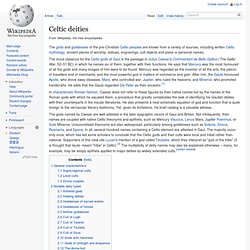
In characteristic Roman fashion, Caesar does not refer to these figures by their native names but by the names of the Roman gods with which he equated them, a procedure that greatly complicates the task of identifying his Gaulish deities with their counterparts in the insular literatures. He also presents a neat schematic equation of god and function that is quite foreign to the vernacular literary testimony. Yet, given its limitations, his brief catalog is a valuable witness.
General characteristics[edit] List of Celtic deities. The Celtic pantheon is known from a variety of sources such as written Celtic mythology, ancient places of worship, statues, engravings, cult objects, and place or personal names.
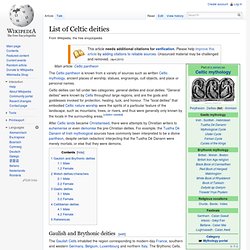
Celtic deities can fall under two categories: general deities and local deities. Grannus. Name[edit] Etymology[edit] In the early twentieth century, the name was connected with the Irish grian, ‘sun’.[1] Along these lines, the god was often linked to the Deò-ghrèine and the character Mac Gréine of Irish mythology.
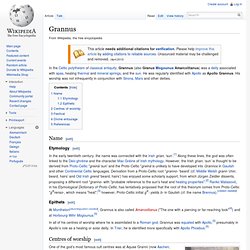
However, the Irish grian, ‘sun’ is thought to be derived from Proto-Celtic *greinā ‘sun’ and the Proto-Celtic *greinā is unlikely to have developed into Grannos in Gaulish and other Continental Celtic languages. Derivation from a Proto-Celtic root *granno- ‘beard’ (cf. Epithets[edit] At Monthelon[disambiguation needed], Grannus is also called Amarcolitanus ("The one with a piercing or far-reaching look"[4]) and at Horbourg-Wihr Mogounus.[5] In all of his centres of worship where he is assimilated to a Roman god, Grannus was equated with Apollo,[5] presumably in Apollo’s role as a healing or solar deity. Centres of worship[edit] Hot springs such as those at Aquae Granni (today's Aachen) are thought to have been dedicated to Grannus. Áine. Áine (Irish pronunciation: [ˈaːnʲə]) is an Irish goddess of summer, wealth and sovereignty.
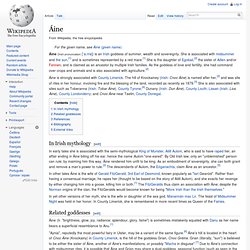
She is associated with midsummer and the sun,[1] and is sometimes represented by a red mare.[1] She is the daughter of Egobail,[2] the sister of Aillen and/or Fennen, and is claimed as an ancestor by multiple Irish families. As the goddess of love and fertility, she had command over crops and animals and is also associated with agriculture.[2] Áine is strongly associated with County Limerick. The hill of Knockainey (Irish: Cnoc Áine) is named after her,[2] and was site of rites in her honour, involving fire and the blessing of the land, recorded as recently as 1879.[3] She is also associated with sites such as Toberanna (Irish: Tobar Áine), County Tyrone;[4] Dunany (Irish: Dun Áine), County Louth; Lissan (Irish: Lios Áine), County Londonderry; and Cnoc Áine near Teelin, County Donegal.